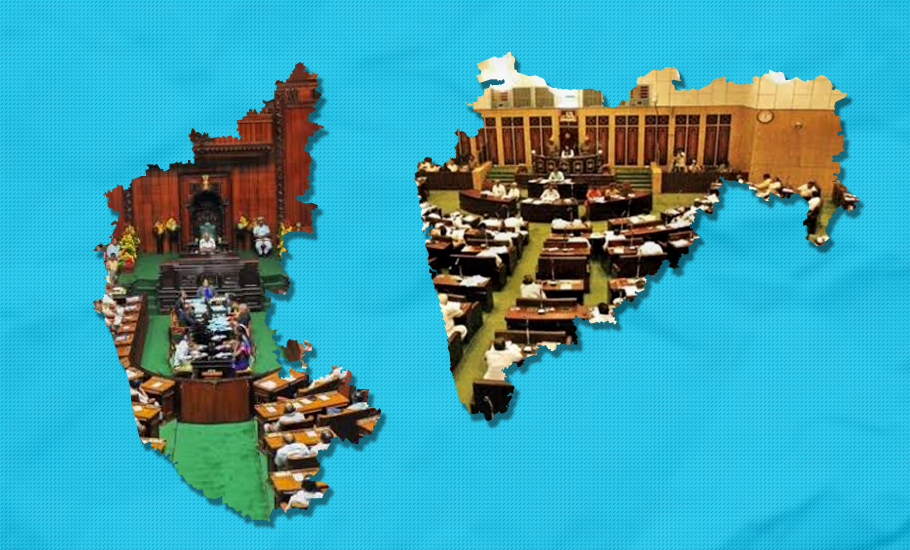
Chronicle of Maharashtra Assembly’s fate foretold

The way now seems clear for the Shiv Sena-led combine to form government in Maharashtra following the resignations of Chief Minister Devendra Fadnavis and renegade NCP deputy chief minister Ajit Pawar on Tuesday. But, if this coalition imagines that the path is smooth for the next five years, it is living under a delusion.
All that the alliance managers have to do is cast their look across to their neighbouring state of Karnataka to descend to a more grim reality. A situation similar to Maharashtra occurred in Karnataka in May 2018. The governor hurriedly swore in BJP leader B S Yediyurappa as the chief minister even though it was short of majority and its possible ally, the Janata Dal (Secular) had already aligned with the Congress. The JD(S) and the Congress together comfortably crossed the mid-way mark of 112.
The governor had given 15 days’ time for Yediyurappa to prove his majority on the floor of the house. But the Supreme Court, on a plea by the Congress-JD(S), struck that down and ordered it to be held in 24 hours, similar to Maharashtra now. Yediyurappa had no choice but to step down as the numbers went against him and a Congress-JD(S) coalition came to power with H D Kumaraswamy as chief minister.
Also read: Opinion | On Constitution day, Maharashtra exposes inept, immoral institutes, SC should step in
The BJP was down definitely, but not out. Smarting under the humiliation of having to step down, it kept poking fun at the new government, criticised it for taking a few weeks too long to organise the ministry etc. These criticisms were political, understandable and par for the course. What was really questionable was its simultaneously covert attempts to destabilise the government by enticing legislators from the ruling alliance.
The coalition resisted valiantly, at least twice exposing the BJP and its ousted chief minister B S Yediyurappa of trying to poach its legislators. Eventually in July 2019, a little over a year after the coalition came to power, the BJP moved in for the kill getting at least 17 legislators to “resign” ( in effect defect) and then defeated the Kumaraswamy government on the floor of the house.
Maharashtra seems all set to take a similar path. For now the legislators of the SS-NCP-Congress are safe under lock and key – from the marauding ways of the BJP. Once this coalition displays its winning strength on the floor of the Assembly, their MLAs will go home and to their constituencies. It is logical that they will then be vulnerable to the approaches by the BJP.
Also read: Fadnavis gets a day’s time to show numbers; pro-tem speaker to conduct floor test
After all, many of the legislators have been in all the three parties one time or the other and their personal friendships and rivalries cut across party lines. How will the SS-led combine control access to their legislators? Let us also remember that once the SS-led coalition takes over government, it will have to form a ministry.
It is not possible for all the legislators to be accommodated in the ministry. There is bound to be resentment and even anger among a section that will expect a berth. After all, there are no great ideological bonds linking the three parties or even within any of the individual parties.
Words like development, progress, poverty alleviation, rural distress and economic progress have turned into empty rhetorical terms meant for public rallies during election campaigns. It is all about being in power and, most if not all, legislators enjoy all the trappings that come with it — like what people witnessed in Maharashtra’s midnight coup last week that saw a chief minister and his deputy being sworn in at an unearthly hour behind closed doors by a Constitutional functionary called the governor.
Also read: Democracy has been murdered in Maharashtra: Rahul Gandhi
So, dissension will begin after ministry formation and that is when the BJP under its master planner Amit Shah will get down to work. Before long, someone within the SS-led ranks will raise the flag of revolt. On record, the BJP will wash its hands off the revolt saying it is an internal issue of the SS-led combine as one witnessed in Karnataka when Congress legislator Ramesh Jarkiholi rebelled, in what was the beginning of the end for the coalition government.
Before long, Maharashtra too will see something similar happen. Unlike in Karnataka, the Shiv Sena has a reputation for strong arm methods to keep its flock in place but its influence is mostly centred in Mumbai and it cannot hope to police the entire state.
As for the NCP, already it has been dented with the number two Ajit Pawar defecting to the BJP’s camp. So that makes it eminently vulnerable.
Also read: BJP gets another 24 hours as SC reserves Maharashtra verdict
The Congress is quiet but this is one party that has historically been known to be the least cohesive politically. So it will be child’s play to rattle its stumps.
All in all, the SS-led combine’s stay in office will be short-lived unless the BJP has a change of heart and decides it will abide by constitutional moralities. But this party, under Prime Minister Narendra Modi and his aide Amit Shah, has already displayed to the country it has no qualms in how the BJP comes to power but that it should.
For the SS-led combine, therefore, the challenge is not in winning the floor test and coming to power but in ensuring how its vastly disparate entities stay put together for the next five years. Pipe dream, would you say?


